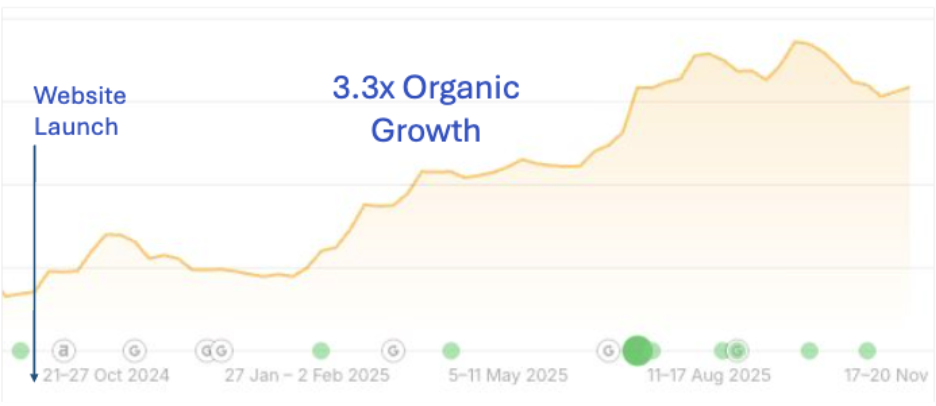
At BrandCraft, we spend a lot of time thinking about how websites look and how visitors will navigate the site. But high-performing websites aren’t just visually impressive, and, as much as it’s overlooked, they have to be structurally aligned with the way search engines crawl, index, and evaluate content. When web design supports SEO foundations, every marketing channel performs more efficiently. Websites load faster, rank more consistently, convert more effectively, and deliver better results across paid and organic channels.
This is the foundation of SEO-friendly web design: a design approach built on technical discipline, intuitive user experience, clean structure, and performance-focused decisions that make it easier for both people and search engines to understand your content.
Overall: a well-designed website is a multiplier for SEO and all performance-driven marketing.
SEO-friendly web design refers to building a website that is optimized for both search engines and users. It goes beyond aesthetics and focuses on:
When these elements come together, search engines better understand your site’s purpose and users are more likely to take action. BrandCraft approaches SEO-friendly design from a performance lens: form and function working together to support marketing efficiency, organic ranking strength, and overall business outcomes.
A website is the center of every marketing ecosystem. If the site structure, layout, or load speed is working against you, it impacts every paid and organic channel.
An SEO-friendly, performance-focused web design helps:
1. Improve Quality Scores in SEM
Fast pages, intuitive navigation, and relevant content support better landing page experience — a major factor in Quality Score. Higher scores lower your cost-per-click (CPC) and improve efficiency.
2. Strengthen Organic Ranking Signals
Google prioritizes sites that load quickly, offer stable experiences, use clean semantic code, and demonstrate content authority. SEO-friendly design enhances all these factors.
3. Increase Conversions and User Engagement
Clear structure, consistent design patterns, and thoughtful UX create frictionless paths that encourage action.
4. Reduce Paid Media Waste
Whether your paid advertising budget is thousands or tens of thousands, a well-optimized website ensures your paid traffic isn’t slowed down, confused, or bouncing early.
Simply put: SEO-friendly design gives your marketing a stronger foundation to work from. That’s why so many high-performing brands view design as a performance channel, not just a creative one.
SEO-friendly design begins with a sound technical foundation. Without it, even the best visuals and messaging won’t perform as expected.
Here are the technical SEO fundamentals your website must support:
Google Search Console should confirm:
Strong technical foundations allow everything else — design, content, UX — to perform more effectively.
Google’s Core Web Vitals are now central to search ranking and user experience. These metrics help measure how quickly and smoothly a site loads:
How fast the main content appears.
How stable the layout is as it loads.
How quickly the page responds to user actions.
Design choices directly influence these metrics:
SEO-friendly web design ensures page elements are optimized, predictable, and fast — all of which benefit SEO, SEM, and conversion rates.
Search engines need to navigate your site efficiently. Users do, too.
SEO-friendly architecture includes:
Use a pyramid model:
All within 3 clicks from the homepage.
A strong internal linking structure helps:
Use descriptive anchor text (“SEO-friendly design principles”) rather than generic links like “click here.”
Breadcrumbs help both users and search engines understand structure. Add schema for BreadcrumbList to enhance this.
Menus should use terms people understand and search for — not internal jargon.
Together, these elements help Google understand your content relationships, meaning your most important pages become easier to rank.
Most companies gain 60-70% of their traffic via mobile search and Google uses mobile-first indexing, so don’t think of your mobile site as secondary.
Best practices include:
SEO-friendly web design makes mobile experience a priority — not an afterthought.
Images are often the single largest contributor to slow load times. SEO-friendly design optimizes them without compromising quality.
When visual assets load quickly and predictably, your Core Web Vitals improve — and so does SEO performance.
Accessible design isn’t just good practice — it supports SEO.
These factors improve usability and help search engines interpret your site’s content more effectively.
Strong content must be easy to read, scan, and rank.
SEO-friendly design and SEO-friendly content cannot be separated — both matter.
Metadata and schema help search engines understand your content more precisely.
Schema isn’t a ranking factor, but better understanding leads to better visibility and improved click-through rates.
To ensure strong performance:
These technical decisions dramatically impact Core Web Vitals — and by extension, rankings and conversions.
SEO-friendly web design is achieved when design, content, performance, and technical SEO work together.
BrandCraft believes great design isn’t measured only by how a site looks, but by how effectively it helps your business grow.
When Seattle Blinds first came to BrandCraft, they experienced minimal organic growth and their ads weren’t converting at a high rate. It didn’t matter if we were adding blog content or even if we addressed basic on-page SEO requirements...the website lacked enough core content and page structure to help it rank.
Following a partial redesign including page expansion, improved site architecture, and some technical improvements, Seattle Blinds’ SEO efforts started paying off big! Following immediate improvements in Q4 2023, their organic traffic and search ranking results have continued to climb, eclipsing 300% growth today versus 2 years prior!

Book a Discovery Session with BrandCraft and see how SEO-friendly web design can improve your SEO, SEM, and overall marketing results.